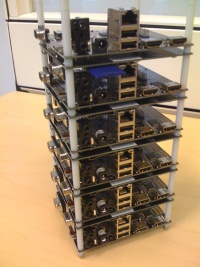| Line 42: | Line 42: | ||
QEMU is also available on Windows but is not yet covered in this guide. For more information on running QEMU on Windows please visit their [http://wiki.qemu.org/Main_Page website]. | QEMU is also available on Windows but is not yet covered in this guide. For more information on running QEMU on Windows please visit their [http://wiki.qemu.org/Main_Page website]. | ||
=Using Fedora | =Using Fedora through QEMU= | ||
The optional kernel packages provide a script to boot Fedora 17 GA from. | |||
==Known Issues== | ==Known Issues== | ||
Revision as of 18:58, 20 June 2012

Versatile Express
Technical Specifications
- 1 GHz Dual core Cortex A9 Processor (OMAP 4430-4460)
- 1 GB DDR2 RAM
- HDMI v1.3
- 10/100Mbit/s Ethernet
- 802.11 b/g/n WiFi
For more information on the Pandaboard visit their website.
Running Fedora on QEMU
This page will give you detailed instructions for running Fedora 17 GA through QEMU. There are four images to choose from when using Versatile Express through QEMU - Hard and Soft Float Versatile Express Images that boot either to a serial console or the XFCE desktop environment. If your not sure which to use, likely you will want to download the Hard Float image. Each requires an external kernel and initrd with a good qemu-system-arm command line; all of which is provided in the boot directory of the kernel file link (or you can extract the files from the main image). This guide will assume you have downloaded both the kernel package and the image.
Download the image
The first step is to download the Fedora 17 image. The prebuilt images include kernels and can be booted without any additional steps or configuration.
- HFP Serial Console Image
- Optional Kernel package: Kernel
- SFP Serial Console Image
- Optional Kernel package: Kernel
- HFP XFCE Desktop Image
- Optional Kernel package: Kernel
- SFP XFCE Desktop Image
- Optional Kernel package: Kernel
Preparing the Image
Linux Users
Extract the downloaded Versatile Express image and kernel using the your graphical user interface or the following commandline option(note in this example we are using the HFP Image):
For the Serial Image:
unxz Fedora-17-armhfp-vexpress-mmcblk0.img.xz unxz Fedora-17-armhfp-vexpress-mmcblk0-kernel.tar.xz
For the XFCE Desktop:
unxz Fedora-17-armhfp-vexpress-xfce-mmcblk0.img.xz unxz Fedora-17-armhfp-vexpress-xfce-mmcblk0-kernel.tar.xz
Windows Users
QEMU is also available on Windows but is not yet covered in this guide. For more information on running QEMU on Windows please visit their website.
Using Fedora through QEMU
The optional kernel packages provide a script to boot Fedora 17 GA from.
Known Issues
- Yum requires the system time be correct for HTTPS to function. If yum updates are not working check your clock.
- Versatile Express images require the kernel parameter 'physmap.enabled=0' be passed to boot correctly. This is included in the boot-vexpress and boot-vexpress+x scripts.
- The tar.xz rootfs archives do not preserve SELinux information or file capabilities. If you use these to create your own filesystem image it is recommended that you switch SELinux to use warnings instead of enforcing for first boot, then relabel and reinstall packages that rely upon filesystem capabilities such as glibc-common and ping.
- Known release issues
Additional Support
There are Fedora ARM users all around the globe - if you need assistance, would like to provide feedback or contribute to Fedora ARM please visit us on the IRC - we can be found in #fedora-arm on Freenode. You can also contact us on the mailing list - arm@lists.fedoraproject.org

